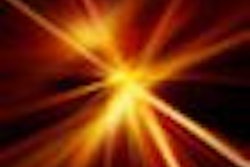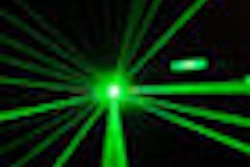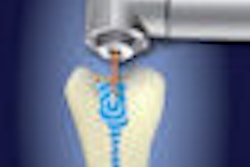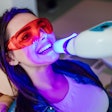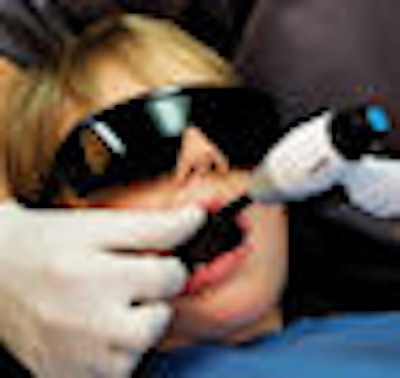
Lasers are often portrayed as powerful beams of light that can cut -- even destroy -- missiles, metal, bone, tissue, and, in some sci-fi movies, aliens from outer space.
Not all lasers are created equal, however. Most laser devices used in dentistry operate at power levels around 2-20 watts -- strong enough to cut and cauterize soft tissue and "drill" hard tissue, yet gentle enough to avoid destroying the tooth, adjacent tissue, or underlying pulp.
|
The science of LLLT Generally speaking, low-level laser therapy works by applying approximately 200 mW of visible or infrared light for several seconds to the target tissue. Light penetrates through the tissue and is absorbed by proteins in the cells without damaging them. In fact, the laser energy has a stimulating chain reaction within the cells (thus the moniker "biostimulation"). Singlet oxygen (free radicals) are generated, stimulating the production of adenosine triphosphate (ATP, which is responsible for transporting chemical energy within cells) in the mitochondria. This in turn produces a number of physiological affects. According to the World Association of Laser Therapy (WALT), these affects include:
|
But an entirely separate class of lasers is intended not to cut or vaporize tissue but to stimulate underlying cellular changes. For years, research has shown that low-level laser therapy (LLLT, also known as phototherapy or biostimulation) can reduce pain and inflammation, accelerate wound healing, and bring relief to patients suffering from chronic conditions such as arthritis and carpal tunnel syndrome.
The concept of using low levels of light-based energy for therapeutic purposes was first proposed by Albert Einstein in 1917. It wasn't until the 1960s that a Hungarian surgeon named Endre Mester first reported on experiments using laser energy to treat infections and inflammations in rats. This work led to the development of LLLT as an adjunctive therapy for pain relief and wound healing, with more than 2,500 published studies supporting its use in a spectrum of medical applications.
The first commercial LLLT product was developed in 1962, and today there are a number of international suppliers, including Irradia (Sweden), Softlaser (Hungary), Thor (Great Britain), MedSolution (Germany), LaserLight (Denmark), Meridian (Korea), Laserex (Australia), and MM Optics (Brazil). But there are only a handful of U.S. suppliers -- primarily MicroLight, Erchonia, Lexington International, and LaserTouch.
In fact, while the concept of LLLT has been widely accepted by the international medical community for pain relief and wound healing for more than 30 years, it has yet to have the same impact in the U.S. According to manufacturers of LLLT devices, the technology has been well-adopted by physical therapists, veterinarians, and professional athletes in the U.S. But other medical professions have been slower to adopt it -- despite the fact that the FDA first granted marketing clearance to LLLT as "adjunctive devices for the temporary relief of pain" in 2002.
"In Europe, they are so far ahead of us in biostimulation," said Chris Walinski, D.D.S., a private practice dentist in Woburn, MA, and an adjunct professor of dentistry at Ohio State who lectures extensively on dental lasers worldwide. "I don't know if [in the U.S.] it is so much skepticism as not enough information. People here just aren't aware of it."
LLLT in dentistry
Similarly, LLLT has a long history in dentistry -- outside of the U.S. According to MedX Health, a Canadian company that developed the Oralase LLLT device for dentistry (currently awaiting FDA clearance), at present there are 325 clinical LLLT studies for dental applications, from 82 institutions in 37 countries, with more than 90% of them reporting positive effects of laser therapy.
For example, a Japanese study on the efficacy of LLLT for treating dentine hypersensitivity found that diode-laser LLLT was effective in reducing dentine hypersensitivity in all 25 study participants (Journal of Clinical Laser Medicine and Surgery, October 2003, Vol. 21:5, pp. 291-296). A more recent study by Brazilian researchers found that diode-laser LLLT accelerates the recovery of dental structures involved in cavity preparation at the predentine region (Archives of Oral Biology, September 2007, Vol. 52:9, pp. 899-903). Another Brazilian study indicated that low-level laser therapy can accelerate tooth movement during orthodontic treatment and reduce pain, leading to greater patient satisfaction and compliance (Lasers in Medical Science, January 2008, Vol. 23:1, pp. 27-33).
On the commercial side, some companies -- including MedX, HomeHealthCare, and Luminax -- are beginning to offer dental-specific LLLT products to the U.S. market, although they still need FDA clearance. Prices range from $4,000 to $6,000.
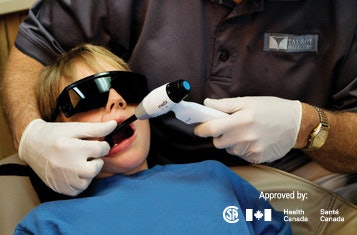 |
| The Oralase LLLT device by MedX Health. |
More than 30 different dental indications have been reported in the literature, according to MedX. Common applications include treating abscesses, oral herpes, denture sores, and hematomas; substituting for anesthesia during crown preparation and pediatric procedures; decreasing dentine hypersensitivity; accelerating nerve regeneration; decreasing pain and accelerating movement of teeth during orthodontic procedures; treating joint and jaw dysfunction such as TMJ and arthritis; speeding the integration of dental implants; and reducing pain and edema following endodontic, restorative, and periodontal surgeries.
Grace Sun, D.D.S., a private practice dentist in Los Angeles and a member of the board of directors of the Academy of Laser Dentistry, began offering LLLT in her practice nearly a decade ago. She uses it daily for applications ranging from easing postoperative pain and swelling to speeding healing of hard- and soft-tissue wounds.
"My patients love it," she said. "They think I am a wonderful doctor."
Gerry Ross, D.D.S., of Tottenham, Ontario, has been in general practice since 1971. He began working with LLLT in 1993 and has been lecturing about the technology since 1996. In his practice, he uses it to prevent pain and promote postoperative healing for all types of surgery. He uses LLLT to stimulate the lymphatic system and reduce edema in infections, as well as ease the pain of TMJ and osteoarthritis. Before restoring a large cavity, he uses LLLT to reduce inflammation and promote secondary dentin. When he restores baby teeth and the teeth of senior adults, he uses LLLT instead of local anesthesia.
"I use it on everybody," he said. "To me, it is the standard of care."
Dr. Walinski first became a LLLT "convert" after twisting his knee while traveling in Italy. A doctor friend suggested letting him treat it with a diode laser he had in his office, and the results were incredible, Dr. Walinski said.
"He treated me for about two minutes and, at first, I didn't feel anything," he said. "But about two minutes later, I started feeling this pop, pop, pop in my thigh and I said, 'What is that?' And he said, 'That's your lymphatics opening up.' And I walked out of there with less swelling and pain."
Today, Dr. Walinksi has at least 10 different lasers in his practice, including a 10-watt diode laser intended for tooth bleaching that he also uses for LLLT. He has developed specific protocols in the range of 1-2 watts for dental treatments such as for TMJ, and he uses the laser after every surgical procedure as a pain management tool.
"I am definitely a believer, but it took a personal experience to make that happen," he said.
Seeing is believing
At this point, it is still unclear what role LLLT will play for the majority of U.S. dentists. In fact, there remains quite a learning curve -- even among laser experts. Several leading dentists contacted for this article declined to comment, stating that their experience with LLLT is too limited or outside their area of expertise. Even Donald Coluzzi, D.D.S., past president of the Academy of Laser Dentistry and an assistant clinical professor at the University of California, San Francisco School of Dentistry, admits he is not that familiar with LLLT.
— Grace Sun, D.D.S., Los Angeles
"I haven't used LLLT on my patients and only know basic information about it," Dr. Coluzzi said. He also pointed out that the phrase "low-power" can be misleading since a lot of dental surgery is performed at 1 or 2 watts, which is low power. "The current phrase for LLLT is being replaced by 'photobiomodulation,' which is more descriptive of the mechanisms and results," he said.
Dr. Ross says education is, in fact, the key to making more people in the dental community aware of the benefits of LLLT. But even that could be a challenge, noted Craig Gimbel, D.D.S., former president of the Academy of Laser Dentistry and now clinical director of Lantis Laser, which is developing an optical coherence tomography imaging system -- not LLLT -- for dentistry.
"You will always have skeptical people who will criticize technology because they are not open to learning about it and the science behind it," he said. "When it comes to LLLT, although there has been so much research done on it, there has been little published about it. Those dentists who are educated about lasers want to know more about low-level lasers."
For the time being, personal experience and word of mouth may be the best educational tools.
"Everyone claims there aren't enough studies, but there are more studies on this than there are studies of higher-power lasers," Dr. Ross said. "We need to get it into the mainstream media. But eventually everyone in dentistry will be using LLLT."
For more information about LLLT and how it can and should be used, go to www.walt.nu, www.laser.nu, www.laserdentistry.org, or www.laserlightcanada.com.




